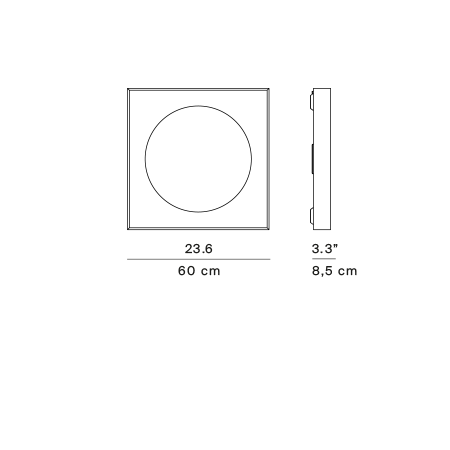CassetteSoffitto Parete
designed by Daniel Rybakken
Lampada a luce diretta caratterizzata da un’ampia superficie illuminante, uniforme e non abbagliante. Sebbene il prodotto risponda ai requisiti tipici dei progetti e sia adatta ad inserirsi in svariati ambiti architettonici, il disegno, che è facilmente riconducibile alla mano di Daniel Rybakken, le dona un aspetto decorativo. Il motore luminoso è costituito da un “pacchetto” ottico, illuminato grazie all’utilizzo della tecnologia edge-lit led. Il corpo è costituito da una cornice estrusa di alluminio e da una lastra (passe-partout) dotata di un taglio centrale a cerchio che consente di emettere la luce nell’ambiente circostante.
A03W44
Cassette 40×40 cm – 2700K

A03W44
Cassette 40×40 cm – 2700K
Specifiche principali
| Typology | Soffitto, Parete | ||
|---|---|---|---|
| Application | Interno | ||
| Material |
|
||
| Finishes |
|
||
| Dimensions (mm) | H 85, L 400, W 400 | ||
| Weight (kg) | 3.9 | ||
| Light Source | 23W (A03/1), 28W (A03/2), MAX 59W, MAX 28W, 2700K, CRI 90 | ||
| Insulation Class | I |
A03W66
Cassette 60×60 cm – 2700K

A03W66
Cassette 60×60 cm – 2700K
Specifiche principali
| Typology | Soffitto, Parete | ||
|---|---|---|---|
| Application | Interno | ||
| Material |
|
||
| Finishes |
|
||
| Dimensions (mm) | H 85, L 600, W 600 | ||
| Weight (kg) | 6.95 | ||
| Light Source | 41W (A03/1), 38W (A03/3), MAX 59W, MAX 53W, 2700K, CRI 90 | ||
| Insulation Class | I |
A03H66
Cassette 60×60 cm – 3000K

A03H66
Cassette 60×60 cm – 3000K
Specifiche principali
| Typology | Soffitto, Parete | ||
|---|---|---|---|
| Application | Interno | ||
| Material |
|
||
| Finishes |
|
||
| Dimensions (mm) | H 85, L 600, W 600 | ||
| Weight (kg) | 6.95 | ||
| Light Source | 59W (A03/1), 56W (A03/3), MAX 59W, MAX 53W, 3000K, CRI 90 | ||
| Insulation Class | I |
A03W99
Cassette 90×90 cm – 2700K

A03W99
Cassette 90×90 cm – 2700K
Specifiche principali
| Typology | Soffitto, Parete | ||
|---|---|---|---|
| Application | Interno | ||
| Material |
|
||
| Finishes |
|
||
| Dimensions (mm) | H 85, L 900, W 900 | ||
| Weight (kg) | 13.8 | ||
| Light Source | 58W (A03/1), 53W (A03/3), MAX 59W, MAX 53W, 2700K, CRI 90 | ||
| Insulation Class | I |






